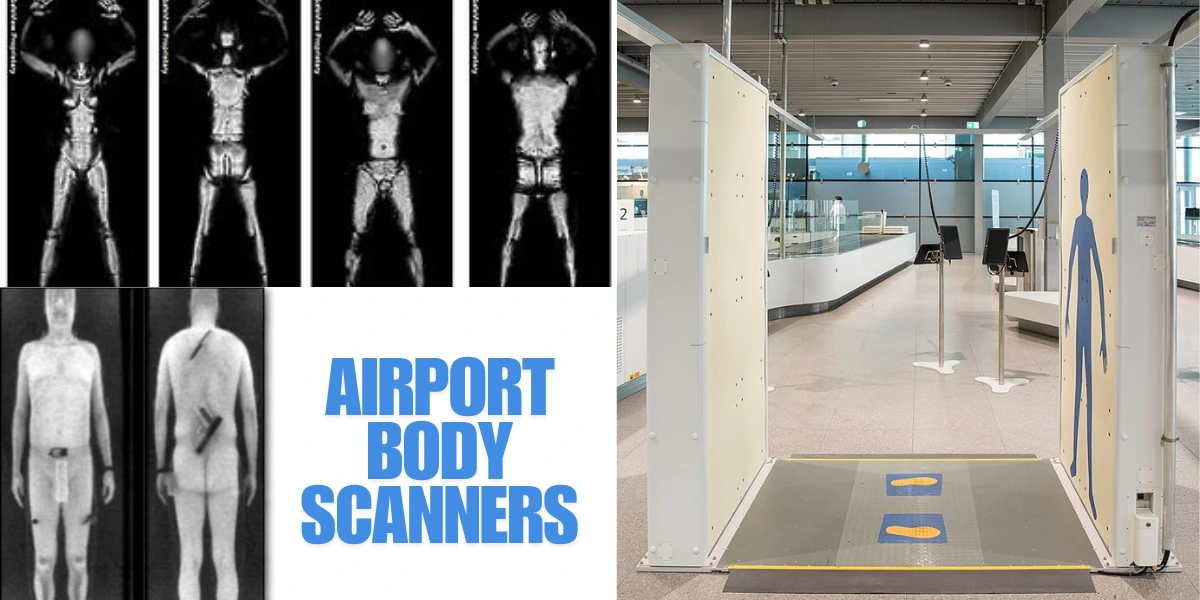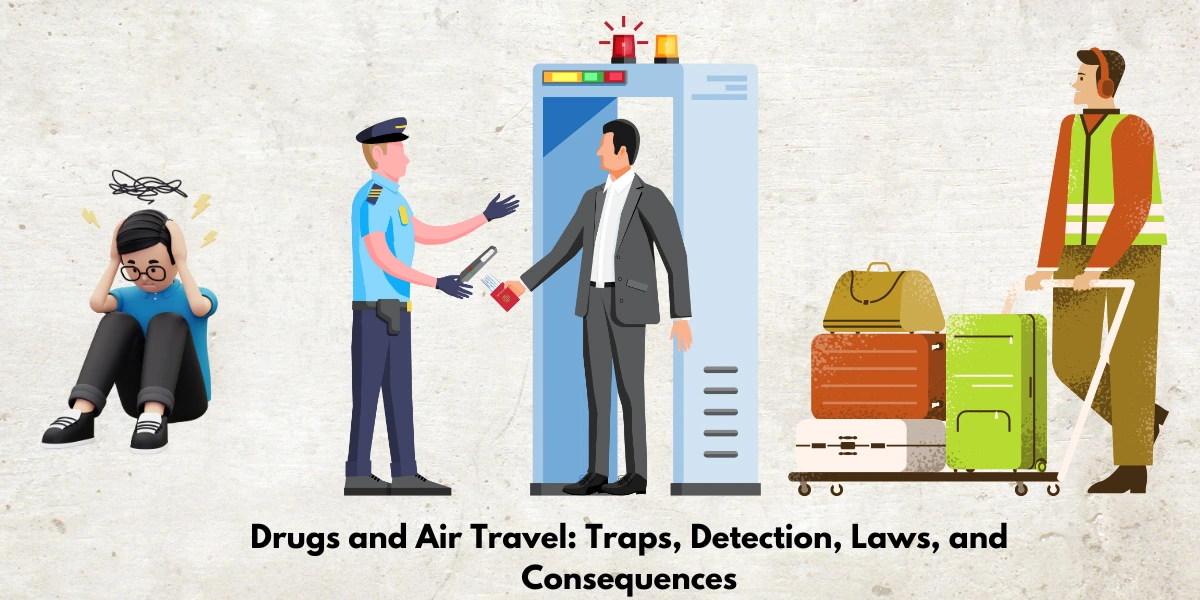What Can Airport Baggage Scanners See in Luggage?
Published: 23 Nov 2024
Advanced scanners can highlight irregularities, spot hidden compartments, and even identify dangerous materials based on their chemical makeup. For example, in 2023, over 4,000 firearms were detected at U.S. airport checkpoints, all thanks to these vigilant machines.

Imagine this: you’re standing at the airport, watching your bag disappear into the mysterious world of security scanners. Have you ever wondered what those machines can really see? It’s more than just knives and liquids. Modern airport scanners are incredibly advanced, capable of identifying almost everything in your luggage—from your laptop to that chocolate bar you forgot you packed—by analyzing the density and shape of each item.
What Can Airport Baggage Scanners See in Luggage?
Airport scanners are like detectives for your luggage, using advanced technology to see what’s inside without opening a single zipper.
Here’s a detailed list what airport baggage scanners can detect:
- Metallic objects
- Non-metallic items
- Organic materials
- Liquids and gels
- Explosive materials
- Batteries and power banks
- Powders
- Hidden compartments
- Sharp objects
- Firearms and ammunition
- Dense or layered items
- Cash
1. Metallic objects
Metallic objects are easily detected by airport scanners due to their density, strong X-ray absorption, and distinct blue appearance in scanner images.
List of Metallic Objects Detected
- Weapons (e.g., guns, knives)
- Electronics (e.g., laptops, phones)
- Jewelry (e.g., rings, necklaces)
- Coins
- Keys
- Tools (e.g., screwdrivers, wrenches)
- Metal parts of clothing (e.g., belt buckles, zippers)
- Metal containers (e.g., flasks, tins)
- Batteries with metallic casings
- Cutlery or eating utensils
2. Non-Metallic Objects
Non-metallic objects are easily visible on airport scanners based on their density and material composition. These items typically appear in green shades on scanner images and can include everyday objects or specialized items requiring further scrutiny.
List of Non-Metallic Objects Detected
- Plastics
- Ceramics
- Glass
- Synthetic materials
- Composite items
- Non-metallic tools
- Non-metallic weaponry
- Plastic containers or bottles
- Toys or gadgets
- Reusable storage boxes
3. Organic Materials
Organic materials are distinct on airport scanners, showing up in orange shades due to their unique absorption of X-rays. These items are often harmless but may resemble contraband or explosives, requiring inspection.
To comply with regulations, liquids and gels must typically be in containers of 3.4 ounces (100 milliliters) or less and placed in a clear, resealable bag.
List of Liquids and Gels Detected
- Water bottles
- Toiletries (shampoo, conditioner)
- Creams and lotions
- Perfumes and colognes
- Beverages
- Liquid medications
- Aerosols
- Gels (hair gel, toothpaste)
- Soups or other liquid foods
- Alcoholic drinks
4. Explosive Materials
Explosive materials are a critical target for airport scanners, often identified using specialized Explosive Detection Systems (EDS). These systems analyze chemical signatures unique to explosives, making it possible to detect even small amounts of dangerous materials. Explosives appear as irregular, dense patterns, prompting immediate inspection.
List of Explosive Materials Detected
- TNT
- C-4
- Ammonium nitrate
- Dynamite
- Liquid explosives
- Plastic explosives
- Gunpowder
- Homemade explosive devices
- Detonators
- Fireworks
5. Batteries and Power Banks
Batteries and power banks are flagged due to fire risks associated with lithium-ion technology. Airport scanners detect their dense metallic casings and energy-dense cores. Regulations limit the size and quantity of batteries that passengers can carry, with large or damaged batteries prohibited.
List of Batteries Detected
- Lithium-ion batteries
- Nickel-cadmium batteries
- Power banks
- Camera batteries
- Rechargeable AA/AAA batteries
- Car batteries (if declared)
- Laptop batteries
- Drone batteries
- Medical device batteries
- Solar chargers
6. Powders
Powders are often inspected closely because they can resemble illegal substances or explosives. Airport scanners highlight powders due to their density and consistency, prompting additional checks if suspicious. Travelers carrying powders should declare them to avoid delays.
List of Powders Detected
- Flour
- Sugar
- Spices
- Protein powder
- Infant formula
- Cosmetics (powder foundation)
- Medicines in powdered form
- Cleaning agents
- Talcum powder
- Baking soda
7. Hidden Compartments
Hidden compartments are flagged when airport scanners detect irregular density patterns or voids within luggage. These compartments are often used for smuggling and are immediately inspected.
List of Hidden Compartments Detected
- False bottoms
- Secret side pockets
- Hollowed-out books
- Shoes with concealed spaces
- Double-layered suitcase panels
- Modified electronics
- Hidden seams or linings
- Stash boxes
- Customized storage containers
- Concealed zippers
8. Sharp Objects
Sharp objects are prohibited in carry-on bags and are flagged by scanners for their distinct shape and density. Security ensures these items are removed or placed in checked luggage to maintain passenger safety.
List of Sharp Objects Detected
- Knives
- Scissors
- Box cutters
- Razor blades
- Nail clippers with files
- Corkscrews with blades
- Swords or replicas
- Tools with sharp edges
- Ice picks
- Metal skewers
9. Firearms and Ammunition
Firearms and ammunition are among the most serious threats detected by airport scanners. They are identified based on their dense metallic components and unique shapes. Transporting these items requires prior declaration and strict adherence to airline policies.
List of Firearms and Ammunition Detected
- Handguns
- Rifles
- Shotguns
- Ammunition cartridges
- Firearm parts
- BB guns
- Pellet guns
- Toy guns that resemble real firearms
- Silencers
- Gun cleaning kits
10. Dense or Layered Items
Dense or layered items in luggage often obscure scanner images, making it difficult to identify other contents. These are flagged for manual inspection to confirm there is no hidden contraband.
List of Dense or Layered Items Detected
- Packed books
- Folded clothing
- Electronics with cords
- Stacked documents
- Food items (cheese, chocolate)
- Compact makeup kits
- Metal cookware
- Wooden items
- Tightly packed gifts
- Sports equipment
11. Cash
Large amounts of cash are detectable by scanners due to the density and uniformity of paper bundles. While not prohibited, carrying significant amounts may prompt questioning to ensure legal compliance.
List of Cash Detected
- Bundled currency
- Loose notes
- Money hidden in objects
- Foreign currency
- Cash belts
- Wallets with excessive money
- Envelopes containing money
- Coins in rolls
- Large sums in safe boxes
- Concealed cash in bags
What Happens If Your Checked Bag Gets Flagged?
If your checked bag is flagged during security screening, here’s what happens step by step:
- Bag is Scanned: Your bag goes through an X-ray scanner. If something suspicious or unclear is seen, it gets flagged.
- Bag is Pulled Aside: Security personnel take the flagged bag to a secure area for closer inspection.
- Bag is Opened: Trained staff open your bag to inspect the contents. They look for items that triggered the alarm, such as prohibited or unclear objects.
- Notification Slip Added: If your bag is inspected, a slip is placed inside to inform you about the inspection.
- Items Removed (if necessary): If any prohibited items are found, they may be removed. Some items might require additional checks by law enforcement.
- Bag is Resealed: Once cleared, your bag is resealed and sent to the plane.
- Law Enforcement Involvement (if needed): If something illegal or dangerous is found, your bag may be held, and law enforcement will review the situation.
- Final Disposal:
- Prohibited Items: Confiscated items like liquids, aerosols, or tools are discarded or held by security.
- Illegal Items: Banned substances or dangerous goods are handed over to law enforcement for further action.
- Abandoned Items: In some cases, passengers may voluntarily surrender items, which are then disposed of securely.
How Do Airport Baggage Scanners Work?
Airport scanners are designed to ensure security by detecting potential threats to luggage or passengers. They utilize electromagnetic waves or X-rays to examine the contents of carry-on and checked bags without opening them. Here are the key technologies in use:

X-Ray Scanners
X-ray scanners are one of the most commonly used tools for airport security. They operate by sending X-rays—high-energy light waves—through your luggage. Different materials absorb these X-rays differently, depending on their density and atomic structure. The scanner collects this information and creates a visual image for security personnel to review.
Color Coding and Material Detection
To make it easier for operators to quickly identify the types of items in your bag, the scanner uses a color-coding system based on the atomic number (Z) of the materials:
- Organic Materials (Orange)
- Examples: Food, paper, clothes, drugs.
- Why Orange? Organic materials consist mainly of carbon (Z = 6), hydrogen (Z = 1), and oxygen (Z = 8), which are low-density elements. Their low atomic numbers allow X-rays to pass through easily, creating an orange shade on the scanner image.
- Metals (Blue)
- Examples: firearms, electronic devices, coins.
- Why Blue? Metals like steel, aluminum, or copper have higher atomic numbers (Z > 13), meaning they absorb more X-rays. This higher absorption results in blue or darker shades.
- Non-Metallic Inorganic Materials (Green)
- Examples: Ceramics, glass, plastics.
- Why Green? Inorganic non-metal materials, such as silicon-based compounds (Z ~ 14), absorb X-rays differently than metals or organic materials, creating distinct green hues in the image.
Practical Use
By differentiating colors, X-ray scanners allow security officers to spot prohibited items quickly. For example, a knife (blue) hidden inside a sandwich (orange) is immediately flagged. The system makes scanning faster and more accurate, enabling airport staff to focus on suspicious bags for further inspection.
CT Scanners (Computed Tomography Scanners)
CT scanners are an advanced version of X-ray machines used to screen luggage. Unlike regular X-rays, which produce flat, two-dimensional images, CT scanners create highly detailed 3D images. Here’s how they work:
- 3D Imaging: CT scanners rotate around luggage, capturing images from multiple angles. These images are then combined into a three-dimensional view, allowing security officers to see objects more clearly and from every side.
- Rotatable Views: Operators can zoom in, rotate, and analyze suspicious objects without opening the bag, improving accuracy in spotting prohibited items like weapons or explosives.
- Accuracy: Because of their precision, CT scanners reduce false alarms and make the screening process faster.
- Adoption: The Transportation Security Administration (TSA) began rolling out CT scanners in 2018, and as of 2022, 630 of these machines are active in U.S. airports. Plans are in place to expand their use globally, improving airport security efficiency.
Millimeter-Wave Scanners
Millimeter-wave scanners are used for scanning passengers instead of luggage. They work differently from X-rays and are designed to prioritize privacy and safety:
- How They Work: These scanners emit low-energy, non-ionizing radio waves (similar to those used in Wi-Fi). These waves bounce off the surface of the body and objects under clothing, creating a scanned image.
- Detection: Suspicious objects like firearms, explosives, or concealed items show up as highlighted areas on a generic body outline.
- Privacy Measures: The image generated is not detailed but uses a generic figure with marked zones for security concerns, ensuring privacy for passengers.
- Safety: Unlike X-rays, these scanners do not emit harmful ionizing radiation, making them safe for frequent use, including for pregnant travelers and children.
Explosive Detection Systems (EDS)
EDS machines specialize in identifying explosive materials hidden in luggage. They go beyond simple density detection and analyze the chemical composition of objects:
- Chemical Analysis: EDS uses advanced sensors to determine the molecular structure of materials in a bag. Explosive compounds, like TNT or C-4, have unique chemical signatures that EDS can identify.
- Integration: These systems often work alongside X-ray or CT scanners to enhance accuracy. For example, if an X-ray scan flags a suspicious object, the EDS can confirm whether it contains explosive materials.
- Efficiency: EDS machines speed up the detection process by reducing the need for manual bag checks. They are also highly reliable in distinguishing harmless items from potential threats.
Can Airport Scanners Detect Hidden Compartments?
Yes, airport baggage scanners can detect hidden compartments. These scanners analyze the density and layout of a bag’s contents using X-rays. Irregularities, such as false bottoms or secret pockets, create anomalies in the image due to unexpected density or structure. For example, items hidden in a hollowed-out book or modified shoe would stand out and be flagged for further inspection.
What Can Airport Baggage Scanners Not See?
Airport baggage scanners are highly effective, but they have some limitations:
- Items obscured by dense materials: If dense items like lead-lined bags, packed books, or metal cookware are in a bag, they can block the scanner’s view, making it harder to identify smaller or concealed items behind them.
- Liquid identification: Scanners can detect liquids but cannot determine their exact composition without additional screening. Suspicious liquids are often flagged for manual inspection.
- Extremely small items: Tiny objects like pins or thin wires may blend with the background and be harder to detect unless highlighted by their location.
- Electronics masking contraband: Stacking or concealing items inside electronics can obscure their detection, though newer scanners with 3D imaging are better at identifying such threats.
Can Airport Scanners See Through Clothes in Luggage?
Yes, airport scanners can see through clothes in luggage. These scanners, typically X-ray machines, penetrate most fabrics to reveal the contents of the bag. Clothes appear as semi-transparent layers, allowing operators to see concealed items like electronics, weapons, or liquids. However, items hidden within very dense or layered clothing might require additional checks.
What Color Do Clothes Show Up on an Airport Scanner?
Clothes generally appear in shades of orange or light colors, as they are organic materials.Denser materials (like metals) appear in darker shades, often blue or black.In newer color-coded systems, organic materials, including clothing, are shown in orange, inorganic materials in green, and metals in blue or black.
What Color Do food items Show Up on an Airport Scanner?
On an airport scanner, food items typically appear in orange because they are organic materials. The exact shade can vary based on the type and density of the food:
- Solid foods (e.g., bread, fruits, meats) often show up in bright or deep orange.
- Dense foods (e.g., cheese, chocolate) may appear slightly darker orange.
- Liquids or gels (e.g., beverages, sauces) also show up as orange but may vary depending on their density.
Final Words
In conclusion, airport scanners are essential for ensuring safety by detecting various materials like metals, non-metals, liquids, explosives, and hidden compartments. Different technologies, such as X-ray, CT, and millimeter-wave scanners, help identify these items, often using color coding for quick detection. While highly effective, some items may require further inspection. If a bag is flagged, additional checks are conducted to confirm safety. Overall, airport scanners enhance security while maintaining efficiency in air travel.

- Be Respectful
- Stay Relevant
- Stay Positive
- True Feedback
- Encourage Discussion
- Avoid Spamming
- No Fake News
- Don't Copy-Paste
- No Personal Attacks

- Be Respectful
- Stay Relevant
- Stay Positive
- True Feedback
- Encourage Discussion
- Avoid Spamming
- No Fake News
- Don't Copy-Paste
- No Personal Attacks





